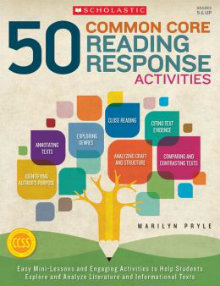50 Easy-to-Implement Reading Response Ideas
50 Common Core Reading Response Activities: Easy Mini-Lessons and Engaging Activities to Help Students Explore and Analyze Literature and Informational Texts
By Marilyn Pryle
(Scholastic, 2014 – Learn more)

The Common Core State Standards for literature and informational texts emphasize the process of acquiring skills to be a close, careful reader. When the CCSS was first introduced, teachers began searching for lessons and strategies to implement these standards.
Resources have become more abundant, and one helpful example is 50 Common Core Reading Response Activities by Marilyn Pryle. Her 50 simple, practical lessons and activities link to the standards in a clearly organized format.

- What type of literature to use it with
- Necessary materials – including reproducible pages
- The CC connection
- Clear directions on how to implement the lesson
- How to assess the work
- Ways to deepen the lesson
“Reading Responses,” the first practice, offered an effective means for students to reference the text. In my own classroom, text evidence is the basis of most reflective responses and often the most difficult so this lesson was a needed strategy added to my “toolbox.”
The “Reading Response (RR) Guidelines” were an especially useful document. Clear-cut suggested responses were listed for students to use as a foundation to begin their writing activity. Some of the examples included:
- Spot the Setting: You notice a part that refers to the place or time of the story or poem, Why is it important?
- Mark the Motivation: You realize a character’s motive(s). Explain the motive(s) and its effect on the story or other characters.
- Cite the Claim: You find the sentence that is the author’s main argument in the story. Explain why it is so important.
The document would be the perfect resource to keep in students’ interactive notebooks to reference throughout the year. “Reading Responses” do not stop, but connect to a deeper assignment including an analysis paper. Students select their top 5 “Reading Responses” and explain why these responses were strong with specific evidence to support their claims.
Other practices in this section include “A Poem a Day,” “Analyzing Art,” “Quote Wall,” “Poetry Modeling,” “Allusion Wall of Fame,” “Own the Text: Annotate,” and “ID the Verb.”
Solving text puzzles
“Individual Activities” provide a variety of approaches to use with different types of texts. Each example contains easy-to-follow steps connected to the Common Core, including variations to personalize the activity. Some of the activities I have seen before, such as a character Facebook page, but a brainstorming sheet is available to be reproduced, saving time from creating my own.
A new approach, “Text Puzzle,” challenges students to reorder jumbled strips of text into the correct order. This activity can be repeated with different types of texts, allowing the genre to come into play when trying to solve the puzzle. Pryle suggests “The beauty of this activity lies in the fact that even if students don’t correctly figure out the original layout, they put themselves in the mind of the author, nonetheless, by trying to guess the author’s purpose and logic.” Students would especially enjoy this activity, unaware of the learning that is taking place.
A few ideas for the next edition
One item that would have been helpful in this resource book is a chart of the CCSS with a list of matching practices/activities that could be used to address the standard. Each lesson does connect to a standard, but I am unable to begin my search with the standard and so need to search each lesson individually. I also would have liked an option to be able to access the documents digitally so I could adjust them to my needs.
50 Common Core Reading Response Activities does provide a plethora of ideas that can be tweaked and changed to meet the needs of the students. It is a resource that fits perfectly into my daily routine, offering common-sense lessons that can be used for modeling, assessing and practice.
Find Marilyn Pryle’s articles on writer conferences as well as a review of her book Writing Workshop in Middle School (2013) here.
Sandy Wisneski is a lead teacher at Catalyst Charter Middle School in Ripon, WI. She is the district Webmaster, tech mentor, yearbook advisor as well as new teacher mentor. Over the past 39 years, she has become certified as a Flat Classroom Teacher and obtained her masters in reading. She is also a Graphite Certified Teacher. The summer of 2014 she attended Honeywell Educators @ Space Academy. She enjoys challenging students to “take ownership” for their learning and to be effective digital citizens in the world.



































